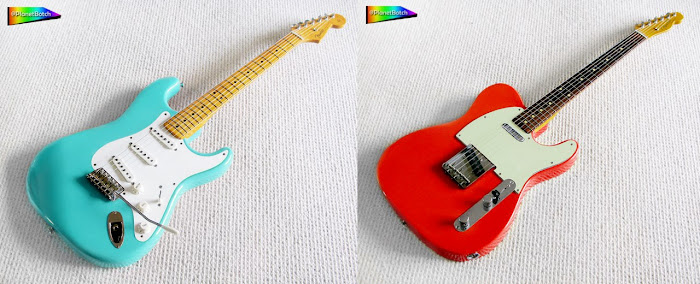I won’t be flying off on a 3,000-word special for this one. The idea is simply to answer one very commonly asked question: “Which will suit me best? A Strat, or a Tele?”. There are obvious differences in appearance, and many guitarists form a preference based on that alone. But Strats and Teles are in the same general ballpark tonally, so normally if you can’t see a glaring reason why you should pick one above the other, then either will make you happy. However, based on the original, traditional designs, here are the main factors which set the standard models apart…
The STRAT has…
A wider range of sounds than the Telecaster, with three pickups and a five-way, rather than a three-way selector switch. Please note, however, that some vintage reissue Strats, and all-original pre-1977 examples, have three-way switches. The five way switch facilitates the distinctive ‘out-of-phase’ funk tones in positions 2 and 4. These are not available on a traditional Telecaster.
An easier-to-reach volume control, which can even be turned with the pinkie whilst playing. However, with some playing styles the knob can too easily be nudged by accident. If you palm-damp a lot over the bridge, the location of a Strat’s volume control can be a problem, with the volume being inadvertently reduced quite frequently.
Greater scope for customisation. Many replacement parts are available for both Strats and Teles, but the Strat’s greater popularity means it has a wider array of options. Also, Strats with ‘universal’ body routing (as on the American Standard Strat forward from 1987) can take a much bigger assortment of pickup designs, pending a simple scratchplate switch. Because the Telecaster’s lead pickup is integrated into the bridge, the options are much more limited.
A vibrato/trem system. As well as the characteristic Strat vibrato shimmer this permits, the system itself, with its bridge block and springs, lends a character to the sound – even when the tremolo arm is not used. Most typically, the Strat’s trem will be set to float, with its metal flatwork off the guitar body. This gives a great feel if you’re going to use the vibrato. However, it seriously compromises harmonised string bends, such as those prolifically used in country guitar playing – essentially sending the ‘static’ strings out of tune when another string is bent against them. This is one reason why Telecasters are more closely associated with country music than Strats.
No tone control on bridge pickup. This is particular to vintage design Strats (and is not the case with current American Standards, for example). It means that there’s no way of reducing the treble of the lead pickup at full volume. However, reducing the volume does by nature tone down the top end at the expense of some output level.
Body contouring for greater comfort when the guitar is played sitting down.
The TELE has…
A fuller bridge pickup sound with more bottom end. A lot of people regard Telecasters as very bright guitars, but they’re not traditionally as bright as Strats. The classic Strat pickup has a resistance of around 6K (K for kilo-ohms or kiloohms), whereas a classic Tele bridge pickup has a resistance of between 7.5 and 8K. Since higher resistance creates a less toppy sound, the Telecaster, according to traditional spec, is definitely fuller. The copper bottom plate on the Tele lead pickup, in conjunction with the guitar’s bridge construction, also helps shape the sound into something more substantial than that of a Strat.
Which of the two guitars is brighter has been contested over the years, largely because the pickups on some Telecasters (particularly non-US Fenders and cheaper copies) have been wound ‘thinner’, with fewer wraps – most likely to save money. When compared with a Strat fitted with hotter pickups, such as Texas Specials, for example, a Tele with ‘underwound’ pickups will sound brighter and thinner. But if the pickups are wound to tradional spec, the Strat is the brighter and thinner-sounding guitar. The issue of the volume control (covered next) can also cause confusion…
A high-pass capacitor on the volume control, so that when the volume is reduced the sound becomes thinner and more toppy, rather than rounder as is the case with the Strat. This is particular to vintage type Teles, and more modern incarnations tend not to have the high-pass capacitor. So, whilst at full volume a vintage Tele will typically sound fuller than a vintage Strat, with volume backed off the reverse will be true.
A deeper and less middly neck pickup sound than the Strat. A traditionally higher number of coil windings plus a metal cover over the pole-pieces makes for a more rounded tone on a Telecaster with the neck position selected. Note that some vintage Tele designs (like the USA ’52 reissue and all pre-1967 original unmodified Fender Teles) are wired so that the ‘front’ position on the selector switch gives a very bassy tone. This is because the neck pickup is routed through a heavy low-pass capacitor - it's not the natural sound of a Tele neck pickup.
Slightly higher output than a traditional Strat. This is due to the greater number of coil windings, and means that a traditional-spec Tele will overdrive a little more easily than a trad Strat.
Better inherent sustain due to the fixed bridge and strings-through-body construction. Strats without trem systems, however, do also have strings-through-body construction, and consequently better sustain.
So, those are the basics of what sets the Strat apart from the Tele in player's terms. If you need to know more detail about Strats and/or Teles, there are numerous retrospectives relating to them on this site...
Telecaster Articles
Stratocaster Articles




